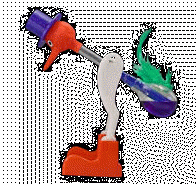|
Infrared radiation
Part II - Absorption
Objectives
• Be able to compare the effectiveness of different
surfaces as absorbers, by considering the nature of the surface.
• Be able to describe and explain how these properties
are used to design more effective appliances and buildings.
Task 1
We are going to carry out an experiment to investigate
how different surfaces absorb infrared radiation, using the following equipment:
2 x conical flasks (1 black, 1 silver)
2 x thermometers
1 x stopwatch
1 x radiant heater
Your teacher will demonstrate how the apparatus is set
up. Draw a labelled diagram in your exercise book and a table to
record the results.
Task 2
Work out the increase in temperature for each flask.
Make a note of your findings by copying and completing the sentences
below:
|
The temperature of the silver flask increased by ______
˚C.
The temperature of the black flask increased by ______
˚C.
In our last experiment we found that ________, ________ surfaces
emitted infrared radiation more effectively than _________, ________ surfaces. The
results of this experiment have shown us that __________, ________ surfaces are
also more effective at _____________ infrared radiation.
We can conclude that good __________ of infrared radiation are
also good _________ of infrared radiation!
|
Task 3
Answer the questions below:
| 1. Why are teapots often shiny? |
 |
| 2. Why are buildings in the Mediterranean
often painted white? How does this help to keep the
houses cool in the summer? |
 |
| 3. Why does a patio heater have a shiny
surface on top? |
 |
|

